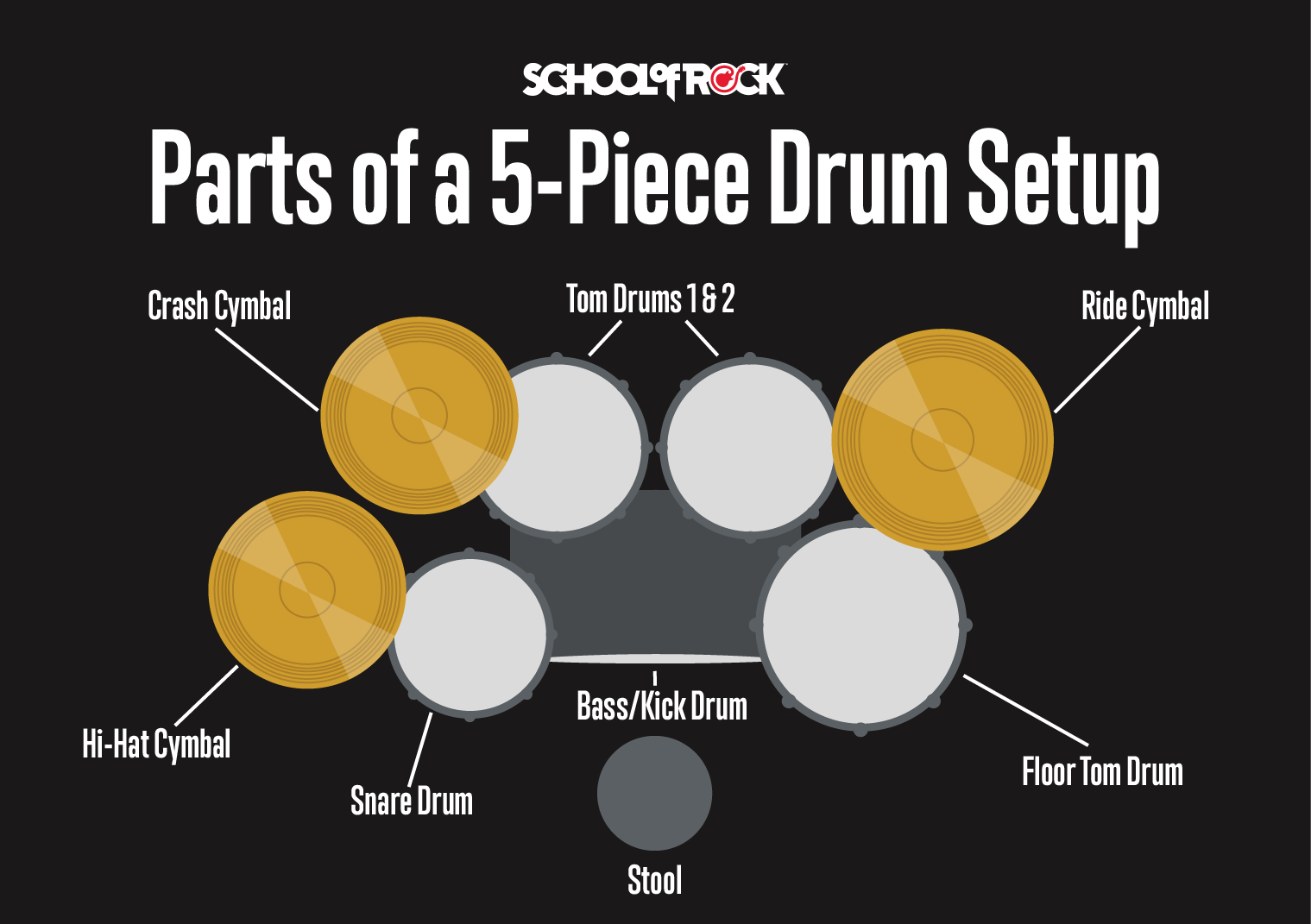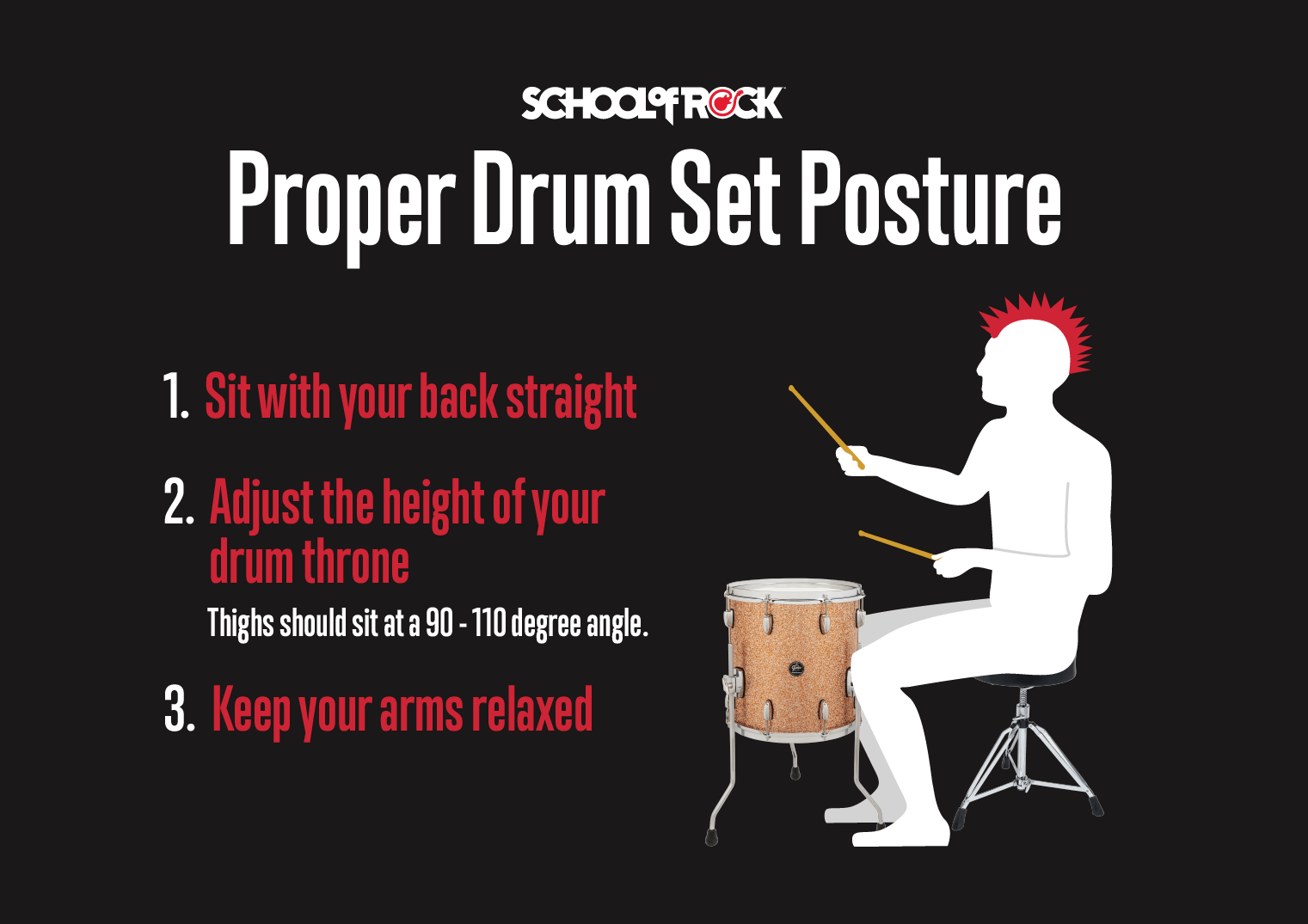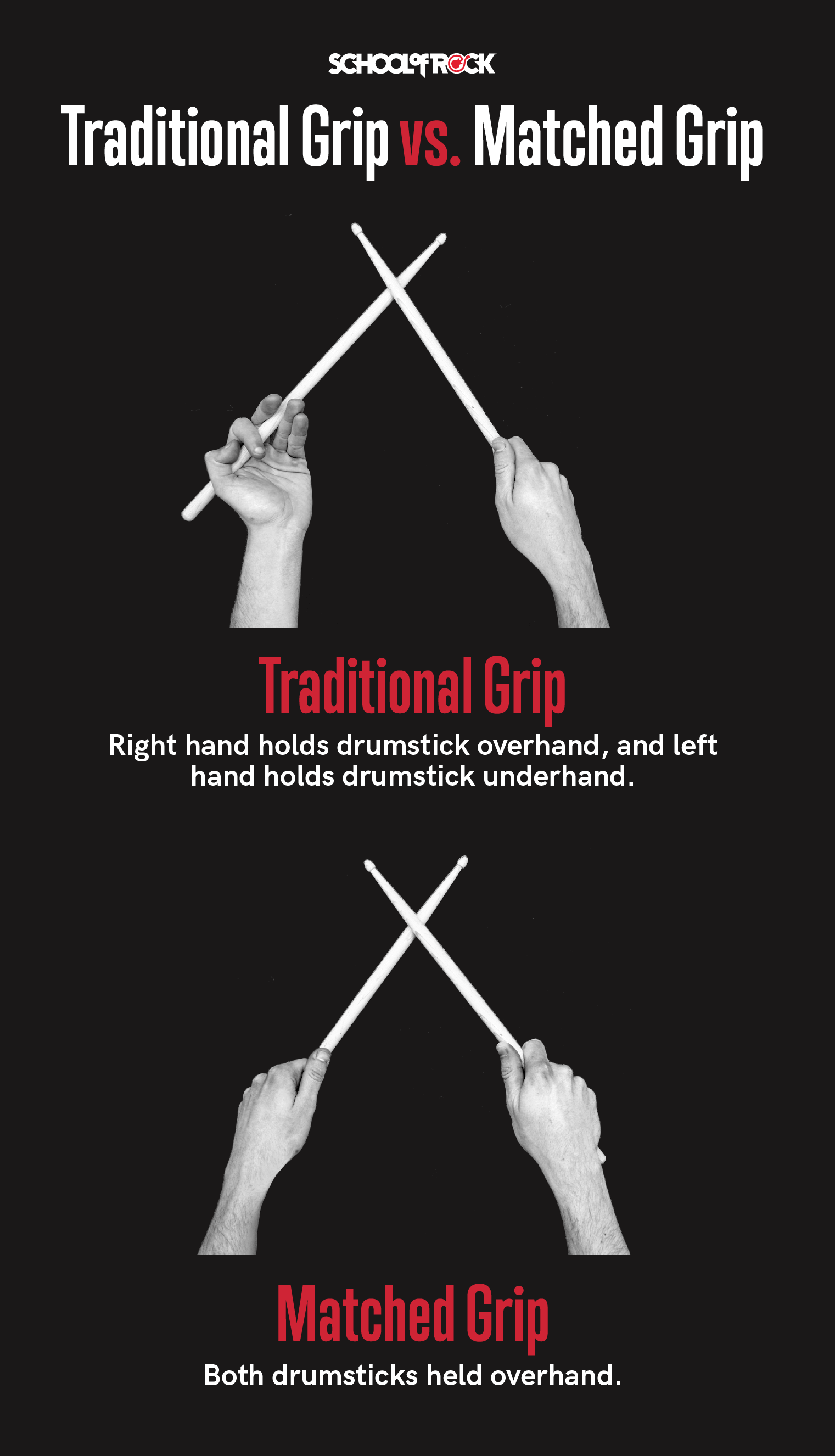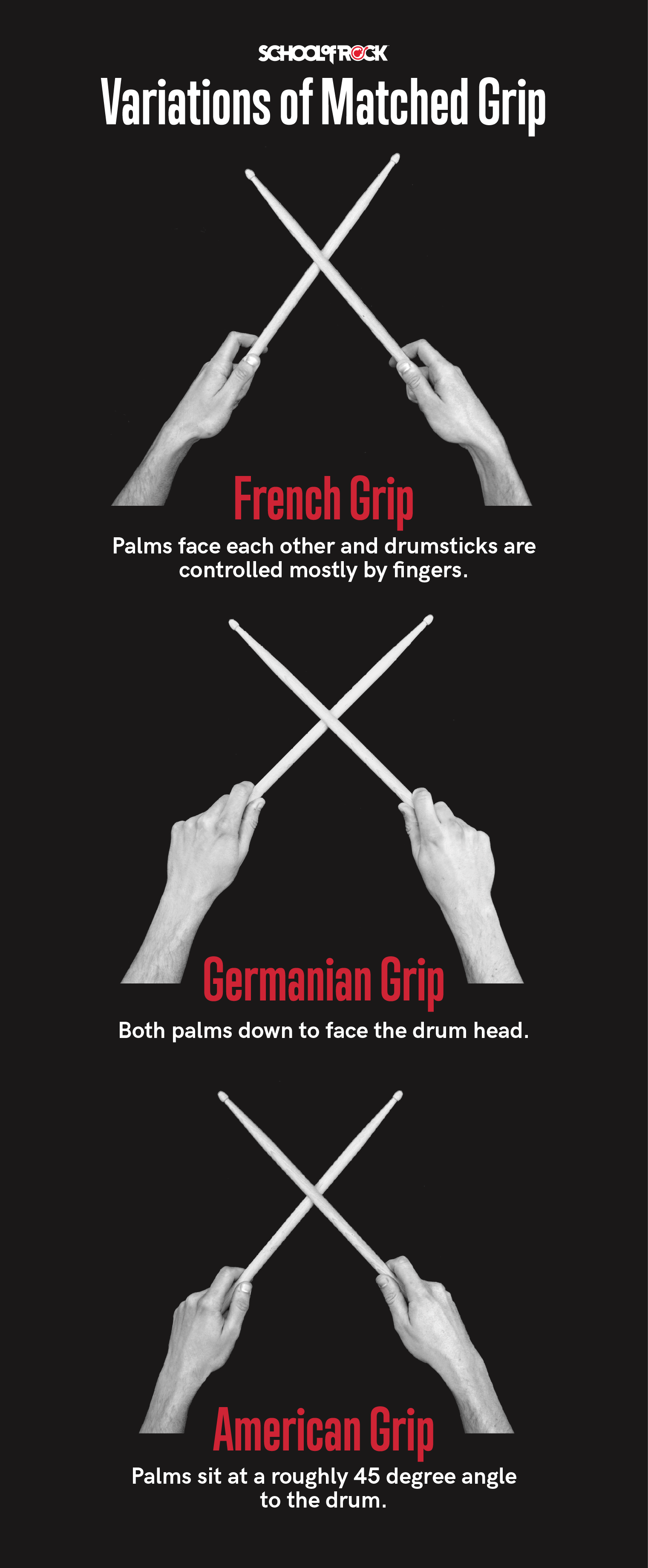Experienced drummers know that how you arrange your drum kit has a direct effect on how you play and what you can do. However, learning how to set up your drum kit can be as challenging as actually playing, especially for beginner drummers! At the School of Rock, we teach musicians the fine points of drumming, from advanced drum techniques to proper drum set posture, so you can play better, avoid injury and sound your best.
How to set up a drum set
When setting up your drum set, you’ll want to change how you arrange your drums based on the number of pieces you’re dealing with. Typically, most beginners start with a 4-piece or 5-piece drum setup, but many musicians add additional components to their as their skills improve.
1. Identify the 3 main parts of your drum kit
Most beginner drum sets have three main components: drums, hardware and cymbals.
- Drums. Most drum sets typically include the bass (or kick) drum, the snare drum and toms.
- Hardware. Common drum hardware includes the bass drum pedal, the throne, and the hi-hat and cymbal stands.
- Cymbals. Different types of cymbals include the crash, the ride and the hi-hats.

2. Set up your bass drum
Place your bass or kick drum so that it’s at the center of your drum kit. Note that your bass drum has adjustable legs. These are used to anchor your bass drum to the floor so it doesn’t move around as you play.
For this reason, it’s important to adjust the legs so they are equal on both sides, since unequal legs will cause your drum set to wobble during play. Check the tips of the legs on your bass drum to make sure they dig into the floor and prevent your drum from sliding around.
3. Adjust your bass drum pedal
When setting up your drum set for the first time, pay special attention to the bass pedal. You can find the bass drum pedal attached to the hoop of your bass drum. As you step on the pedal, the beater should strike the bass drum head in the middle of your drum and then bounce back.
If stepping on the pedal is too hard or makes your legs tired, then you’ll need to adjust the action or tension of the bass pedal to make it less tight. If the pedal stays on the drum head and does not bounce back, then the tension is too loose.
If the tension is too loose, you’ll need to adjust the tension to be tighter so the drum head springs back. Most pedals have a knob or screw that you can turn to control the tension, but this may be different depending on your model.
3. Place your snare drum
As you arrange your drum kit, you will need to adjust the height of your snare drum. The height of your snare drum should be set a few inches above your leg and set so you can easily hit the drum with either of your hands without hitting the rim of your drum.
Set up your drum so your snare throw-off, the lever that engages the snare, is on the left-hand side of your drum. Most drummers set up their snares flat, although traditional players sometimes set their drums so that it slightly tilts down and away.
4. Set up your toms
Most drum sets have two types of toms: floor toms and mounted toms. Your floor toms should be set so it is roughly the same height as your snare drum, while your mounted tom (or toms) should be set up at a slight angle towards you.
The arrangement of your toms can be changed to make it easier to play. For drum arrangements with more than one mounted tom, you can place your toms so they are a few inches apart and sit at equal angles.
If it’s uncomfortable to hit your floor tom, try angling the tom slightly toward you. You may find that angling your toms will be more comfortable than setting them up completely flat, although this can vary depending on the height of your drum throne.
5. Place your drum throne
The drum throne is where you will sit as you play. For increased playability, place your drum throne in a spot where you can reach all components of your drum set. This will allow you to play with the least effort and help you prevent injury.
6. Set up your hi-hat
When sitting at your drum set, the positioning of your hi-hat should be just to the left of your snare. You attach hi-hat cymbals to the rod of your stand using a clutch that secures the top cymbal to the rod. This allows you to open and close the hi-hats. Make sure that the pedal for your hi-hat is in a position where your foot can comfortably reach it.
It’s important that your hi-hat cymbals sit higher than your snare. Setting your hi-hats to the same height as your snare, or lower, might make it harder to hit.
7. Arrange your crash and ride cymbals
Typically, most drummers use one or two crash cymbals and one ride cymbal. Your ride cymbal should be set up to your right, usually just over the floor tom.
If you’re using one crash cymbal, set it up to the left of your kit somewhere between your snare drum and your mounted tom.
If you’re using a second crash cymbal, you should place it between your mounted tom and your floor tom. Make sure both crash cymbals sit a few inches above the mounted toms, but not too high. You’ll want to keep them within a comfortable reach.
How to sit with proper drum set posture
Now that you have your kit set up, let’s talk about the correct posture for drumming. Maintaining proper drum set posture is important because it will help you play more efficiently, improve your sound and decrease your risk of injury.

- Sit with your back straight. When playing your drum kit, keep your back straight. Don’t slouch forward since this puts pressure on your lower back and can cause injury. Watching videos or live performances of professional drummers can help beginners visualize proper posture. If sitting up straight is too difficult, some drum thrones come with a built-in back for additional support as you play.
- Adjust the height of your drum throne. For good posture, adjust the height of your drum throne so your thighs sit at a 90 to 110 degree angle. Setting your drum throne too high or too low will make it harder to play your bass drum, and will make your legs get tired.
- Keep your arms relaxed. When playing the drums, keep your arms close to your sides with your elbows tucked in. This will help you maintain a good drum stroke that produces a good tone. Raising your arms any higher may cause your strokes to sound pushed or forced.
How to hold drumsticks with proper grip
No matter what type of grip you use to hold your drumsticks, your grip should be relaxed and your thumbs should be facing upward. This will give your sticks a proper bounce when they strike the drum heads and result in a better sound.
Traditional grip versus matched grip
There are two main types of grips: traditional and matched.

Traditional drumstick grip
In traditional grip, your right hand holds the stick in an overhand fashion. Your left hand holds the stick in an underhand fashion with the stick resting between the middle and ring fingers. Marching bands and jazz drummers often hold their drumsticks this way.
Matched drumstick grip
For matched grip, hold both of your drumsticks overhand between your thumb and index finger. There are three variations of the matched grip: American, French and German.

- French grip. When using the French grip, your palms face each other and the stick is controlled mostly by your fingers. This drumstick grip allows you to play with more finesse and control.
- Germanian grip. The Germanian or German grip has the palms down to face the drum head. This gives you a strong, powerful stroke that is controlled mostly by the wrist. This is the grip used during the Moeller technique which involves a whipping motion of the wrist.
- American grip. The American grip is a hybrid of both the French and German grip. With this drumstick grip, your palms should sit at a roughly 45 degree angle to the drum. This gives you the finesse of the French grip and the power of the German grip.
No matter which grip you use, maintaining great posture and properly setting up your kit can help you play better, sound better and avoid injury.






